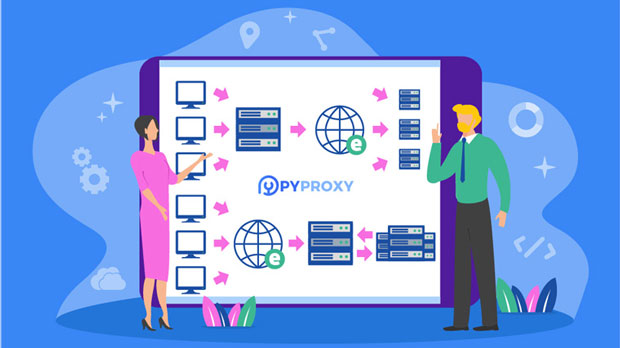How 5G and the spread of IPv6 are affecting the use of proxy IP addresses
The widespread adoption of 5G and IPv6 is poised to significantly influence the use of proxy ip addresses in various ways. As the digital world continues to evolve with faster mobile networks and an expanding internet address system, both 5G and IPv6 bring about a shift in how internet traffic is managed, routed, and anonymized. proxy ip addresses, often used to mask or change an internet user's location and identity, will see changes in their application, effectiveness, and overall demand. Understanding the implications of these technologies is crucial for businesses and individuals alike to adapt to the future of online privacy, security, and internet connectivity. The Evolution of Internet Infrastructure: 5G and IPv6Before delving into the impact on proxy IP addresses, it's essential to understand the technologies behind the changes. 5G technology, the fifth-generation wireless standard, promises ultra-fast speeds, lower latency, and enhanced connectivity. It facilitates better internet experiences for mobile users and connects billions of devices through the Internet of Things (IoT). 5G brings improvements in bandwidth, which allows for smoother online services, higher-quality streaming, and faster data transfers.IPv6, on the other hand, is the latest version of the Internet Protocol, designed to replace IPv4. It addresses the limitation of IP address availability in IPv4, offering an enormous number of new IP addresses to support the growing number of internet-connected devices. This transition becomes increasingly vital as more devices get connected to the internet, which will drive the need for a larger address pool and greater routing flexibility.The Role of Proxy IP AddressesProxy IP addresses act as intermediaries between users and the internet, allowing users to conceal their true IP addresses for various purposes, including security, privacy, and bypassing geographic restrictions. With proxy ips, users can access content as though they are located in a different geographical region or protect their identity from online tracking.The function of proxy IP addresses is crucial for businesses conducting global operations, research, and marketing strategies. They also provide an essential layer of security for individuals seeking to protect their personal information from cyber threats.Impact of 5G on Proxy IP Address UsageThe rapid rollout of 5G technology has several implications for the use of proxy IP addresses. Increased Bandwidth and Speed: With the high-speed capabilities of 5G networks, proxy servers will have to adapt to handle much larger volumes of data. For businesses and users relying on proxies for secure browsing, 5G enables faster data transfer, which increases the demand for efficient and high-performing proxy services. As more devices utilize 5G, businesses may need to upgrade their proxy infrastructures to handle the new volume and maintain the quality of service.Mobile Proxy Demand: The expansion of 5G networks also leads to a surge in mobile internet users, which, in turn, increases the need for mobile proxies. Mobile proxies are critical for businesses engaging in location-based services, market research, or testing mobile apps. With 5G, mobile proxies will become faster, more reliable, and accessible, making them an even more essential tool for businesses.Geographic and Network Flexibility: 5G also provides greater flexibility in terms of network coverage. As 5G networks expand globally, proxy IP addresses can be used to mask users' locations in real time, offering businesses an edge in operations requiring access to geo-restricted content. With the low latency of 5G, proxy servers can efficiently reroute traffic across multiple locations to help businesses bypass restrictions and access valuable data quickly.Privacy and Security Concerns: The enhanced speed and low latency of 5G also highlight the growing need for secure online practices. More internet traffic flowing through high-speed networks increases the potential for data breaches. Proxy servers continue to be vital tools for users who wish to safeguard their identity and online activity, particularly in scenarios where quick data transfer and real-time internet access are necessary.The Impact of IPv6 on Proxy IP Address UsageAs IPv6 adoption continues to grow, it significantly influences the way proxy IP addresses are used.Unlimited IP Address Availability: One of the key advantages of IPv6 is the sheer volume of IP addresses it provides, which eliminates the scarcity of IPs seen with IPv4. This has several implications for proxy IP services. With IPv6, proxies will no longer be limited by the constrained pool of addresses, meaning more unique IP addresses will be available for users to choose from. This will lead to improved anonymity and diversity in proxy IP options, which is particularly valuable for businesses engaged in global research, testing, and scraping.Decentralization and Routing Efficiency: The increase in IP address space with IPv6 improves routing efficiency by enabling better decentralized routing across the internet. For businesses relying on proxies for tasks such as web scraping or market analysis, IPv6 allows for more direct routing of internet traffic, reducing the need for intermediary proxy servers. This results in lower latency and faster connections.Enhanced Anonymity and Security: IPv6 addresses provide more distinct and secure identifiers for devices on the network. This helps businesses improve anonymity by using proxies that utilize IPv6 addresses. With the greater availability of IP addresses, users and businesses can rotate proxies more frequently, making it harder to track or identify them. Additionally, since IPv6 often incorporates improved security features, such as end-to-end encryption, the use of proxies on IPv6 networks can further enhance privacy and security.IPv6 Adoption and Compatibility Challenges: Although IPv6 adoption is on the rise, there are still challenges when it comes to full compatibility with existing systems. Many networks and websites are still running on IPv4, and this dual-stack environment creates a situation where businesses need to use both IPv4 and IPv6 proxies. It requires careful management and configuration to ensure smooth operations, especially in regions where IPv6 adoption is still growing.Future Trends and ConsiderationsAs 5G and IPv6 technologies continue to proliferate, there will be ongoing changes in the use and need for proxy IP addresses.Integration with AI and Automation: The integration of artificial intelligence (AI) and automation in proxy services will play a key role in the future. With the rise of 5G and IPv6, businesses will require more sophisticated proxy systems capable of handling high volumes of traffic and adapting to real-time changes in internet usage patterns. AI-driven proxy systems will help automate the process of IP rotation, load balancing, and traffic rerouting, improving overall efficiency.Demand for Specialized Proxies: As the internet landscape shifts, the demand for specialized proxy services will increase. Businesses may require proxies for specific tasks, such as accessing 5G-powered mobile networks, conducting geolocation-based research, or interacting with content on IPv6-enabled networks. This demand will lead to the growth of niche proxy services catering to the unique requirements of industries like e-commerce, advertising, and cybersecurity.Proxy Server Optimization: The growing complexity of networks will drive the need for proxy servers to become more optimized. These servers will need to be capable of handling the higher speed and data throughput of 5G, as well as efficiently managing the massive pool of IP addresses enabled by IPv6. Proxy service providers will need to focus on optimizing their infrastructure to ensure high-quality, low-latency connections.ConclusionThe widespread adoption of 5G and IPv6 will undoubtedly transform the landscape of internet connectivity, security, and proxy IP usage. The increased speed, low latency, and expanded address space provided by 5G and IPv6 create new opportunities and challenges for businesses and individuals who rely on proxies for privacy, security, and online operations. As these technologies continue to evolve, it is essential for businesses to adapt their proxy strategies to stay ahead in a rapidly changing digital environment. Understanding the relationship between these technologies and proxy IP usage is key to navigating the future of the internet securely and efficiently.
2025-02-17

























































